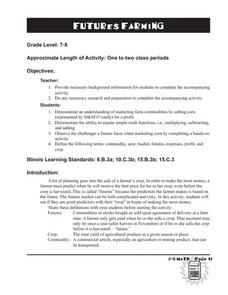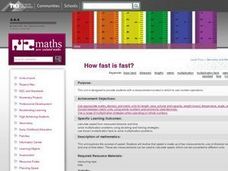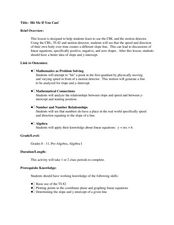Curated OER
Solving Various Algebraic Equations for Real and Imaginary Roots
In this solving equations worksheet, students solve forty-four algebraic equations for real and imaginary solutions. Types of equations include higher degress polynomials, rational equationals, radical equations, and square roots inside...
Curated OER
Mathematics Within: Algebraic Patterns
Students comprehend that ratios and fractions are interchangeable. They compare ratios using common denominators, cross multiplication, and intuition. Students find equivalent fractions. They comprehend that equivalent ratios do not...
Curated OER
How does the Earth compare to the other planets?
Young scholars equate the size of the planets by determining their relative size. In this planet's size lesson, students use a variety of measurements to evaluate the sizes of the planets. Young scholars share their comparisons and...
Curated OER
Field Exercise: Stream Flow Dynamics & Sedimentation
Students produce a vertical profile of a stream and map and define thalweg, point bar, and cut bank. They measure flow velocity differences across a stream transect and equate flow velocity with size of substrate sediment collected.
Curated OER
Comparing Candy Bars
Eighth graders identify that a ratio is a comparison of two numbers and that a proportion is an equation that equates two ratios. They identify the extremes and means of proportions, as well as the product of the extremes equals the...
EngageNY
Bacteria and Exponential Growth
It's scary how fast bacteria can grow — exponentially. Class members solve exponential equations, including those modeling bacteria and population growth. Lesson emphasizes numerical approaches rather than graphical or algebraic.
Curated OER
Budget Mania
Students examine several examples of budgets to develop a facility with the components of its formation. Income, expenses, and expenditures are considered and itemized for this lesson.
Curated OER
Wallflowers: Adding and Multiplying Integers
Students solve word problems in which they add, subtract, multiply, and/or divide integers, identify rules and patterns for multiplying and dividing integers, create scenarios that represent each expression, and evaluate expressions.
EngageNY
Similarity
Learn similarity through a transformations lens! Individuals examine the effects of transformations and analyze the properties of similarity, and conclude that any image that can be created through transformations is similar. The...
EngageNY
Why Were Logarithms Developed?
Show your class how people calculated complex math problems in the old days. Scholars take a trip back to the days without calculators in the 15th installment of a 35-part module. They use logarithms to determine products of numbers and...
Curated OER
Farmers Dilemma
Learners investigate the "futures" market and how it affects farmers by completing a prediction activity utilizing bags of M&Ms. While completing this activity, students practice basic mathematics skills and reinforce economic terms.
Curated OER
Language Arts, Social Studies, African Americans, The Blues, To Kill A Mockingbird
African American history during the Jim Crow era includes encounters with poverty, racism, disrespect, and protest. Harper Lee develops all four of these themes in her famous 1960 novel, To Kill a Mockingbird. To help learners understand...
Curated OER
How Fast Is Fast?
Students make sensible estimates and check the reasonableness of the answers. Students write and solve problems involving decimal multiplication and division. Students perform calculations with time.
Curated OER
Mass: Applying and Interpreting
Students rotate through six studying stations solving problems that involve applying and interpreting aspects of mass. They solve various word problems, and measure the contents of cans and calculate the mass of two cans.
Curated OER
Fruity Math
Students solve one step linear equations. In this algebra lesson, students manipulate their variables and numbers to answer each problem. They make sure the equations stay balanced at all times.
Curated OER
Introducing Linear Terminology
Ninth graders graph linear equations and inequalities in two variables and then, they write equations of lines and find and use the slope and y-intercept
of lines. They use linear equations to model real data and define to define the...
Curated OER
The Big Bang Theory
Students explore the Big Bang Theory and discover how it can be used to explain the origin of the universe. For this Big Bang Theory lesson, students use a balloon with colored paper inside, blow it up and pop it, group the colored...
Curated OER
Properties of Logarithmic Functions
Students solve exponential functions. In this algebra lesson, students identify the properties of logarithmic and exponential functions. They graph their functions and solve using change of base formula.
Curated OER
Equations, Formulas and Identities
Students rewrite word problems using the correct symbols. In this algebra lesson, students find the trigonometric identities and use them to solve problems. They write equations for the trigonometric ratios.
Curated OER
Hit Me If You Can!
Learners graph linear equations using slopes and intercepts. In this algebra lesson, students identify the slope as being positive,negative or undefined. They differentiate between different quadrants on a coordinate plane.
Other popular searches
- Algebra Equations Worksheets
- Algebra Equations
- Solving Equations
- Linear Equations
- Balancing Chemical Equations
- Systems of Equations
- Graphing Linear Equations
- Quadratic Equations
- Chemistry Equations
- Multi Step Equations
- Algebraic Equations
- Hands on Equations






















